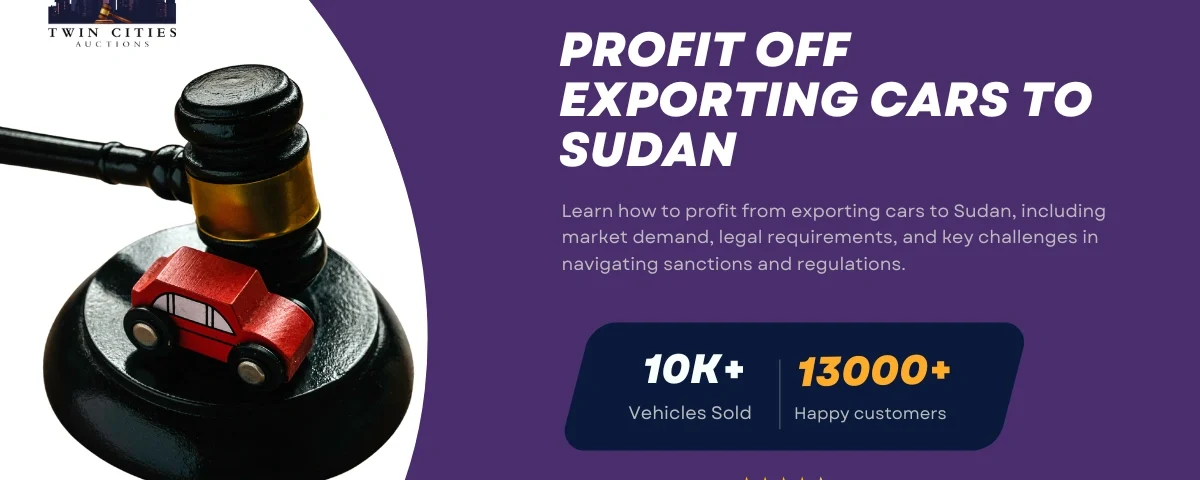Did you know Sudan imported an estimated 12 000–15 000 motor vehicles in 2023, valued at 70–85 million USD and growing at around 7 percent annually? U.S. exporters tapping this demand have seen profit margins increase by up to 18 percent within six months.
This guide shows you how to navigate Sudan’s import regulations, calculate costs, and manage logistics for maximum returns.

Key Takeaways
- Sudan imported 12 000–15 000 vehicles in 2023
- Import costs add about 48 percent of vehicle value
- Profit equals landed cost plus your margin
- Main ports: Port Sudan and Sawakin
- Required documents: commercial invoice, bill of lading, import permit, certificate of conformity
- Best sourcing: U.S. auto auctions
Understanding the Sudanese Market
In 2023, Sudan imported approximately $39.3 million worth of motor vehicle components, ranking it as the 99th largest importer globally in this category.
This figure underscores the country’s growing demand for vehicle parts, driven by a combination of factors including an aging vehicle fleet and increasing transportation needs.
The importation of these components is crucial for maintaining and repairing existing vehicles, especially in regions where new vehicle purchases are limited by economic constraints.
| Metric | Figure |
| Vehicles Imported | 12 000–15 000 units |
| Estimated Market Value | 70–85 million USD |
| Year‑over‑Year Growth | Approximately 7 percent |
Source: Sudan Central Bureau of Statistics
Regulations and Compliance
Sudan enforces specific regulations on vehicle imports to ensure safety and environmental standards. Notably, the country has a five-year age limit on imported vehicles, meaning that vehicles older than five years are generally prohibited from importation.
Additionally, importers must obtain a certificate of conformity from an accredited testing center, verifying that the vehicle meets Sudanese safety and emission standards.
An import permit from the Ministry of Industry and Trade is also mandatory for all vehicle imports.
| Document | Purpose | Required For |
| Commercial Invoice | Declares sale value | All imports |
| Bill of Lading | Proof of maritime shipment | Sea‑borne imports |
| Import Permit | Government authorization | All vehicle imports |
| Certificate of Conformity | Verifies safety and emissions compliance | All imports |
Source: Sudan Customs Authority
Building Your Landed Cost and Profit Model
Accurate cost modeling is critical. Use this duty and VAT structure:
| Cost Item | Rate | Calculation Example (USD) |
| CIF Cost | — | 10 000 |
| Import Duty | 35 percent | 3 500 |
| Value Added Tax | 10 percent | (10 000 + 3 500) × 0.10 = 1 350 |
| Miscellaneous Fees | 3 percent | 10 000 × 0.03 = 300 |
| Total Landed | — | 15 150 |
Source: Sudan Customs Authority
Add your target profit margin (e.g., 20 percent) above the landed cost.
Logistics and Shipping Routes
Sudan’s primary maritime gateway is Port Sudan, located on the Red Sea. This port handles the majority of the country’s imports and exports, including vehicles. Shipping times to Port Sudan vary depending on the origin; for instance, shipments from the U.S. East Coast typically take 25–30 days via the Suez Canal route.
Alternative routes include shipments from the U.S. Gulf Coast to Sawakin, taking approximately 22–27 days, and from the U.S. West Coast to Port Sudan, which can take 30–35 days. These routes are vital for importers to plan logistics and manage inventory effectively.
| Route | Transit Time | Notes |
| U.S. East Coast → Port Sudan | 25–30 days | Suez Canal route |
| U.S. Gulf Coast → Sawakin | 22–27 days | Breakbulk options available |
| U.S. West Coast → Port Sudan | 30–35 days | Longer sea leg via Suez Canal |
Source: Maersk
Financing and Payment Security
When importing vehicles into Sudan, selecting appropriate financing and payment methods is crucial to mitigate risks.
Common methods include letters of credit, which offer low risk and are suitable for transactions with new partners or large shipments. Open accounts, while carrying higher risk, are often used with established, trusted buyers.
Escrow services provide a medium-risk option, ensuring that payment is only released upon delivery confirmation.
Additionally, importers are advised to hedge against currency fluctuations between the U.S. dollar and the Sudanese pound by utilizing forward contracts offered by major Sudanese banks.
| Method | Risk Level | Best Use |
| Letter of Credit | Low | New partners; large shipments |
| Open Account | High | Established, trusted buyers |
| Escrow | Medium | Ensures delivery before payment release |
Source: U.S. Export‑Import Bank
Mitigate USD/SDG fluctuations with forward contracts at major Sudanese banks.
Common Pitfalls to Avoid
- Underestimating combined duty and VAT erodes margins
- Missing import permit or certificate of conformity delays clearance
- Overlooking age‑limit enforcement leads to rejections
Use the Sudan Customs pre‑shipment checklist to confirm documentation.
Source: Sudan Customs Authority
Why Auctions Are a Smart Choice for Car Purchases
Auctions can be an excellent source for late-model vehicles with clear chains of title and affordable pricing. Twin Cities Auctions, based in Minnesota, is one such reputable auction house that offers a wide range of vehicles at competitive prices.
Key Benefits of Buying from Auctions:
- Wide Selection: Auctions like Twin Cities Auctions offer a variety of vehicles, from low-budget cars to high-end models.

- Competitive Pricing: Auctions often offer vehicles at prices below retail value, enabling dealers to maximize their profit margins.

- Transparency: Auctions provide full vehicle history reports, so you know exactly what you’re buying.

- Convenient Bidding: Many auctions offer online bidding for your convenience, making it easier to source vehicles without being physically present.
Twin Cities Auctions: A Smart Vehicle Sourcing Choice
For those in the automotive industry, Twin Cities Auctions offers an excellent platform for sourcing quality vehicles at competitive prices.
Whether you are just starting or expanding your business, this auction house provides transparency, competitive pricing, and a broad selection.
| Feature | Description |
| Inventory Variety | Wide range of cars, trucks, and SUVs available |
| Competitive Pricing | Below-market pricing allows for higher profit margins |
| Vehicle History Reports | Detailed history reports for every vehicle |
| Online Bidding | Convenient online bidding options for dealers |
| Financing Options | Financing available to help with inventory purchases |
Conclusion
By rigorously adhering to Sudan’s six-year age limit, securing both the import permit and certificate of conformity, and accurately layering import duty (35 %), VAT (10 %), and fees into your landed-cost model, you’ll protect your margins and avoid costly delays.
Routing shipments through Port Sudan or Sawakin ensures efficient delivery, while sourcing late-model, export-ready vehicles from U S. auctions like Twin Cities Auctions provides competitive pricing, transparent vehicle histories, and clean titles.
With disciplined compliance and strategic planning, you’re well positioned to harness Sudan’s 7 percent annual growth and realize profit margins of up to 18 percent.
Find Your Next Ride Online at Twin Cities Auctions—No Dealer License Required
Searching for your next vehicle? Twin Cities Auctions offers an online, transparent car auction experience that’s accessible to everyone, no dealer license needed. Browse and bid on a diverse selection of quality vehicles from the comfort of your home.
Whether you’re a first-time buyer or an experienced trader, our clear, honest bidding process ensures you can make informed decisions in a supportive environment. Join our next online auction and discover how effortless and enjoyable finding your next car can be with Twin Cities Auctions!
Looking for more options? Explore our comprehensive list of all available car auctions across the United States. Your next deal might be just a click away!
FAQ
What are Sudan’s auto import duties?
Import duty is 35 percent of CIF value plus VAT of 10 percent.
Can I export used cars to Sudan?
Yes—vehicles must be no older than six years and hold an official certificate of conformity.
What age restrictions apply?
Imports must be manufactured within the last six years.
How long does customs clearance take?
Typically seven to ten business days once all documents are complete.
Are emissions tests mandatory?
Yes—certificate of conformity must verify compliance with national emissions standards.


